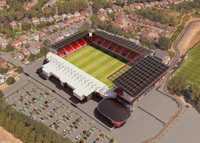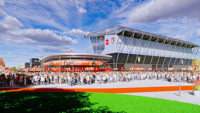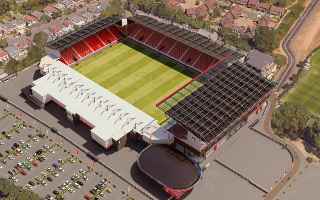Vitality Stadium
| Capacity | 20 196 |
|---|---|
| Country | England |
| City | Bournemouth |
| Clubs | AFC Bournemouth |
| Category | Design awaiting implementation |
| Cost | ? |
| Construction | 2026–2027 |
Advertisement
Vitality Stadium – design description
What does the Vitality Stadium expansion project look like in brief?
The expansion of AFC Bournemouth’s stadium will almost double its capacity, giving the smallest Premier League stadium a chance to shed this unenviable distinction.
The centerpiece of the project will be a new stand behind the south goal, accommodating 7,000 spectators and becoming the tallest structure at the stadium. The plan also includes expanding the north and east stands and adding corner sections.
The project will also involve interior renovations of the stands and new hospitality areas. Outside, a new fence, ticket office, and covered fan zone will be built.
Work is scheduled to begin in early 2026 and finish before the start of the 2027/28 season. The project will be carried out in phases, with the stadium remaining fully operational throughout construction.
What is Vitality Stadium like?
Vitality Stadium, traditionally known as Dean Court, has a history dating back to 1910. The stadium underwent a major transformation in 2001, when the pitch was rotated 90° and new stands were constructed. Initially, only three sides were built, leaving the south end without a stand.
The south side of the stadium has seen several temporary stands over the years: the first from 2005 to 2008, the second in 2010–2011, and a third built in 2013. The 2013 stand was the first to have a roof, but it was still a temporary structure planned for five years. After this period, it was decided to keep it in place for longer.
The stadium is located within Kings Park in the Boscombe suburb, about 2 miles (3 km) east of Bournemouth town center. Comprising four straight, covered stands, it retains a typical English style. Its capacity of around 11,300 makes it by far the smallest stadium in the Premier League.
Who are AFC Bournemouth?
AFC Bournemouth is a football club founded in 1899, originally named Boscombe after the suburb. In 2015, the team achieved its first-ever promotion to the Premier League. Between 2020 and 2022, Bournemouth played in the Championship, before earning promotion back to the top flight in 2022.
At the end of 2022, new owners Black Knight Football Club – a partnership led by American businessman Bill Foley and Cannae Holdings – took over the club. In the long term, the club and its owners aim to compete in European competitions.
How did the plans to expand Vitality Stadium come about?
When were the first expansion plans drawn up?
The club had long signaled its intention to build a permanent stand behind the south goal. The first plans for a new south stand were presented in 2016 – it was to be taller than the other stands and would have increased the stadium’s capacity to around 14,500 spectators.
Could AFC Bournemouth build a new stadium?
However, the stadium did not belong to AFC Bournemouth – in 2005 the club sold it to Structadene and had been a tenant ever since. This move helped the club clear its debts but became an obstacle for expansion plans, as the team’s owners were unwilling to invest in a venue they did not own.
The club wanted to buy back the stadium, but negotiations did not produce the desired result, which led them to develop an alternative plan: building a new stadium at a different location.
In July 2017, it was announced that a new stadium would be built near Vitality Stadium, within the same Kings Park. These plans were later shelved due to insufficient funding.
When was AFC Bournemouth’s new training complex built?
Instead of a new stadium, the club began developing a modern training facility. In early 2018, they purchased land from the former Canford Magna Golf Club on the northern outskirts of Bournemouth.
Construction started in 2019 but was paused due to the COVID-19 pandemic. Work resumed in 2022, and the training complex officially opened on 25 April 2025.
How did AFC Bournemouth’s new owners view the stadium issue?
At the end of 2022, the American company Black Knight Football Club acquired a majority stake in the club. The new owners believed that the situation with such a small Premier League stadium needed to be addressed. Initially, however, no decision was made on whether to expand the existing venue or build an entirely new stadium.
When were the latest expansion plans for Vitality Stadium drawn up?
During the inauguration of the new training centre on 25 April 2025, AFC Bournemouth chairman Bill Foley announced that an agreement had been reached to buy back Vitality Stadium from Structadene—removing the biggest obstacle to its expansion.
Shortly afterwards, the club shared its stadium expansion plans—the first visualisations and project details were published on 15 July 2025.
What does the Vitality Stadium expansion project involve?
The Vitality Stadium expansion plan includes the construction of a new stand behind the south goal, the extension of the north and east stands, the addition of corner stands, and the renovation of the east and west stand facilities.
Outside the stadium, a covered fan zone and a new ticket office will be built behind the south-west corner, and fencing and new entrance gates are planned around the stadium.
The new south stand will replace the temporary structure from 2013 and will hold 7,000 spectators. It will be the tallest stand in the stadium, reaching 30 m—significantly higher than the expanded north and east stands, which will each be 16.5 m tall.
Raising the upper tiers of the north and east stands will increase their capacities by 1,200 and 1,700 seats respectively, while the new corner stands will add another 1,440 seats. The renovation of the east and west stands will include new hospitality areas, increasing the number of premium seats by 600.
The plan also includes further changes to the stadium surroundings, such as optimising the parking layout and modifying vehicle traffic routes.
Will Vitality Stadium remain the smallest in the Premier League?
The investment will significantly increase the stadium’s capacity, from around 11,300 to 20,200 spectators. While it will still be among the smallest in the Premier League, the expansion offers hope that it will no longer be the absolute smallest—though this ultimately depends on the league’s composition in the coming seasons (and whether AFC Bournemouth remains in it).
When will the Vitality Stadium expansion take place?
The first work at Vitality Stadium is set to begin in early 2026. During the expansion, the stadium will remain open and matches will continue to be played there.
The preliminary phase of the project includes the installation of fencing, new entrance gates, and the ticket office, as well as renovations of the east and west stands. This part of the project is expected to be completed by March 2026.
The first phase of the main construction will involve building the new south stand and the corner stands. Upon its completion, planned for August 2026, the stadium’s capacity will increase to 17,296 spectators.
In the second phase, the north and east stands will be expanded, bringing the stadium’s total capacity to 20,196. This work is expected to be completed by August 2027.
Advertisement
Renderings
-

2025 © AFC Bournemouth 
2025 © AFC Bournemouth 
2025 © AFC Bournemouth 
2025 © AFC Bournemouth
Related news
2025
-

England: AFC Bournemouth plans expansion of Vitality Stadium
AFC Bournemouth has submitted a request for permission to start preparatory work for the expansion of Vitality Stadium. The club stresses that the investment is crucial to achieving its goal of playing in European competitions by 2030.
-

England: AFC Bournemouth reveals plans to expand Vitality Stadium
AFC Bournemouth aims to complete the Vitality Stadium expansion by the start of the 2026/27 season. The biggest change will be a new south stand replacing the current temporary structure. Its capacity will jump from 2,337 to around 7,000 seats.

 StadiumDB
StadiumDB